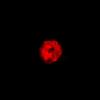Intracellular staining at 4C - HELP - (Jan/03/2014 )
Dear all,
I often recur to these forums for tips but this time I must ask anew... I have a student in the lab trying to do an antibody staining against an extracellular epitope of calcium channels. The idea is to look only at channels at the membrane so she has tried to do a live staining at 4C then fixate before the secondary or to first fixate the cells in 2% PFA then apply the primary antibody. In both cases there is a strange INTRACELLULAR signal (confocal microscopy), not seen with the secondary alone. The live staining was, however, done in a saline containing calcium, magnesium, glucose, (the same as she uses for electrophysiological recordings). Could this strange staining be caused by the calcium or other component of the solution? I do not want to have her do it again and again for no good reason... anybody had this type of experience? Would using PBS be more advisable or do you think the issue is other than the solution bathing the cells. But then again, why was the same seen in fixed cells? I have heard that strong fixation can damage membranes, possibly allowing for antibody access to the inside, but this was only 2% PFA...
Any thoughts are very welcome.
And a very Happy New Year!!!
Best,
Paulo.
Welcome to the forum.
I suspect that the issue is more likely to be with internalization of the receptor after the antibody is bound. Have you tried fixing before the antibody is applied?
If you can provide more info about the protocol you are following, that will be helpful. Especially the steps leading up to secondary staining.
Thanks for your reply!
The protocol used is roughly as follows:
the cultures plates are placed on ice, medium aspirated and washed with cold extracellular solution (in mM): 145 NaCl, 2.8 KCl, 2 CaCl2, 1 MgCl2, 10 HEPES and 11 glucose, pH 7.2 (this is the same as used to perfuse the cells in electrophysiology experiements). The primary antibody was then applied in the same solution for 1h (on ice), washed in cold PBS 2x then fixed with 4% PFA (10 min on ice then 10min RT). Washed with PBS 3x, blocked with 3% BSA in PBS and secondary applied in PBS 1h at RT, then mounted. Attempts were also made to fixate the cells beforehand with 2,3 and 4% PFA, then do a regular antibody staining protocol without detergent permeabilization. In all cases this intracellular staining was seen. Sample image is attached together with a secondary-only control (the one with almost no sitgnal at all). As you can see there is signal everywhere, even in the nucleus! Both pictures were taken with the same settings on the confocal.
Thanks again!
I don't think the buffer will be causing this as it looks like a pretty ordinary ionic strength buffer with a bit of glucose, unless the calcium channels are bigger than I thought and could allow transport of the antibody along with the calcium. The rest looks pretty standard, but I would be a bit worried that the washes aren't stringent enough so you may be seeing some non-specific staining. You could use a detergent that won't puncture the membrane well (e.g. 0.1% tween-20) to increase the stringency or use 2x PBS.
Different antibodies like different fixation methods - have you tried methanol fixation? Check the antibody datasheet, as it may tell you which conditions to use. Make sure that the antibody will detect native epitopes if you are using PFA. You could also try fixing after the secondary, as this should cross-link the antibodies together, making the signal more stable.
Has the antibody been used for this method before? Successfully? Is this a published method? If so what did the authors do (often not explained in detail)? Has the antibody been titrated for IF?
Finally - could you post the DAPI picture too please?
Thanks again! I have no DAPI picture since we use GFP to find infected cells only. There is one image in the supplier's web page of a live staining (last one in the bottom)
https://www.alomone.com/p/anti-cavalpha2delta4_%28extracellular%29/acc-104/977
I will be trying this again at 4C in PBS and see how that goes. I still cannot believe there is so much intracellular signal at 4 degrees C. when everything was pre-cooled... there must be something wrong with the previous attempts...
I will post back when I get the results.
The reason I asked for a DAPI stain was to check for mycoplasma contamination. DAPI isn't very good at picking it up though. DAPI will also tell you where in the stack you are - from your image you could easily be at the bottom of the cell, near the slide and as such on the membrane.
Are you using it at the 1:50 they recommend?
Hi again,
the picture is from the middle of the stack. If you look carefully you can see the contour of the nucleus on the left side, which is rather large in these adrenal chromaffin cells. The signal is everywhere except for some nuclear areas... The dilution used was 1:50, as indicated in the supplier's webpage.
My biggest puzzle is really how did all the antibodies go inside the cell at 4C in the live staining... I can only guess that in the live staining the presence of divalent cations may have caused some sort of precipitation that made the antibody enter the cell, like with DNA transfection... Never heard of it though... Then in the fixed preparation the PFA somehow made holes in the membrane... I will try a new live staining in PBS: apply primary, wash, apply secondary, wash and only then fixate. I cannot really use 2x PBS on live cells for washing but do you recommend a very small amount of detergent or would you advise against it? And what about BSA/Serum in the antibody solution?
Best,
Paulo.
Blocking could well help.
Compare your protocol to this one (skip down to "2").
Thanks a lot for all the help! She has followed the suggested protocol and now it worked! Whatever was going wrong with the previous attempts remains to be explained...
Excellent!
Best wishes,
Paulo.


